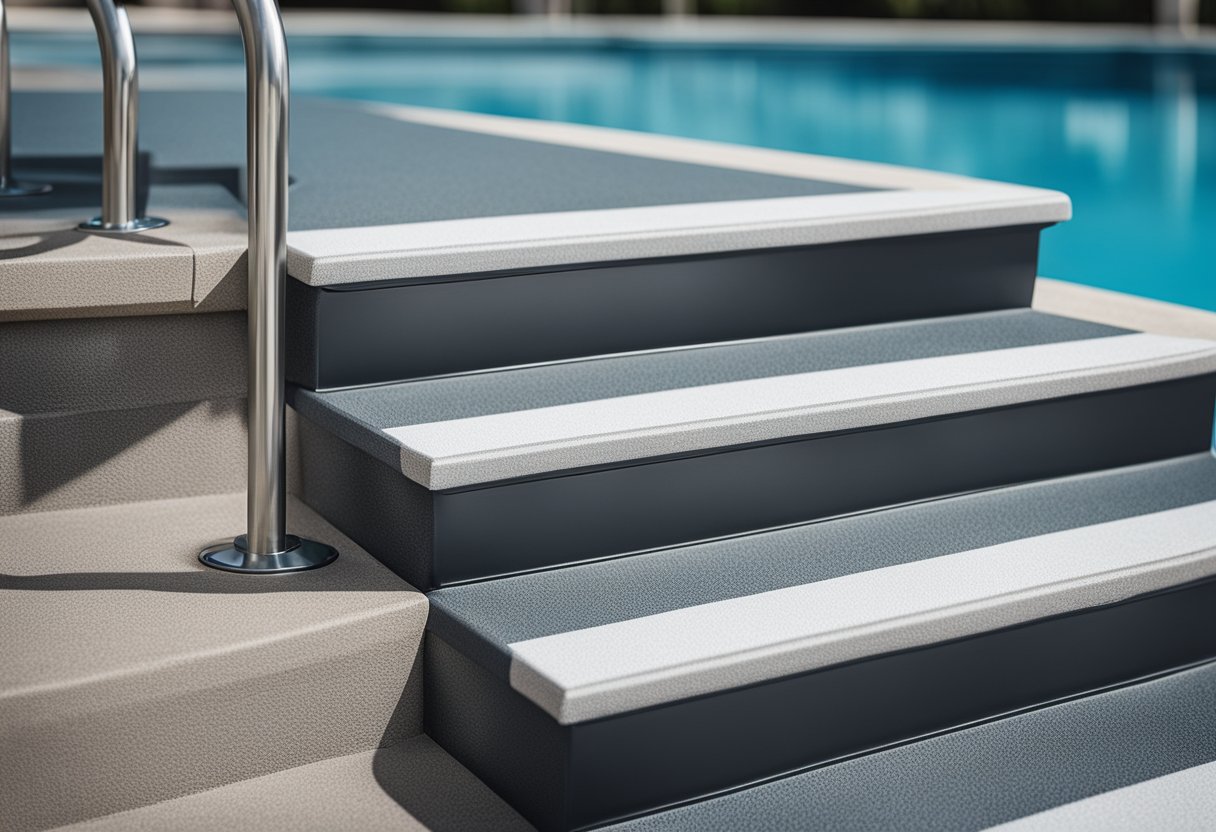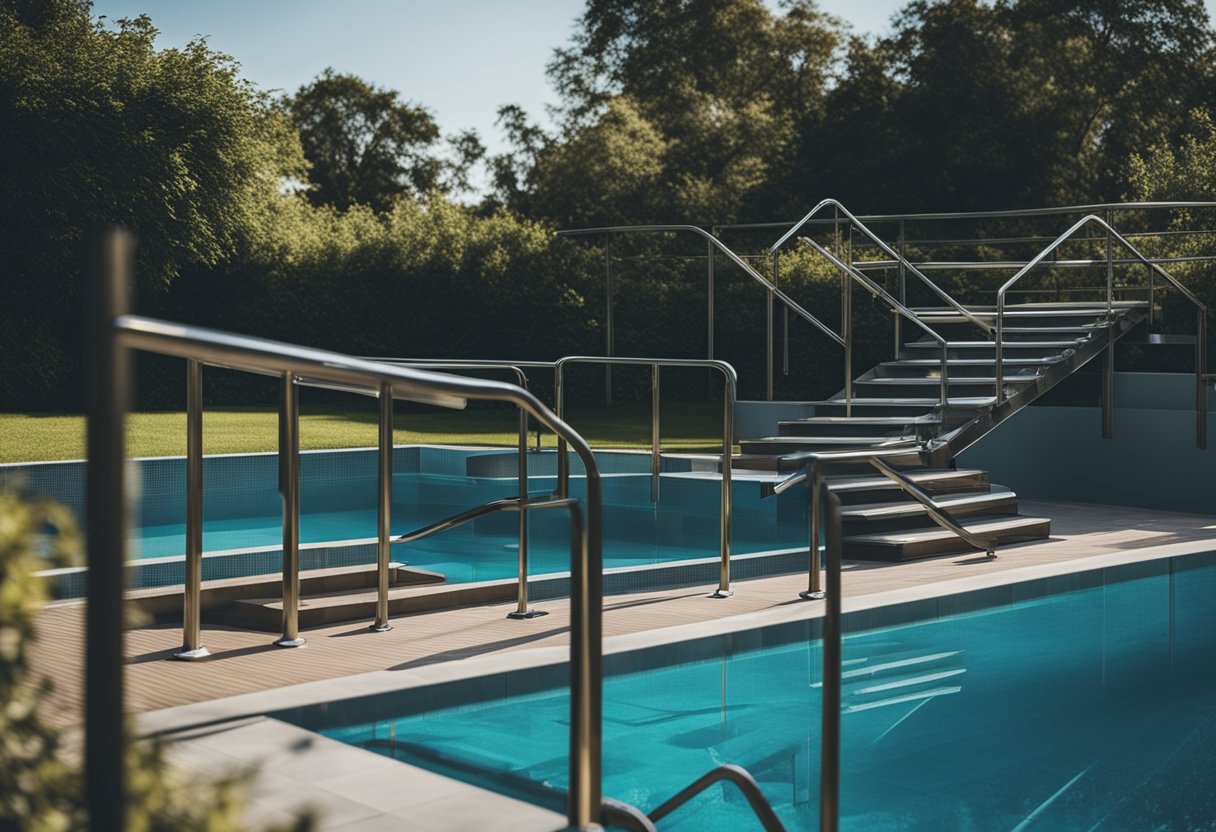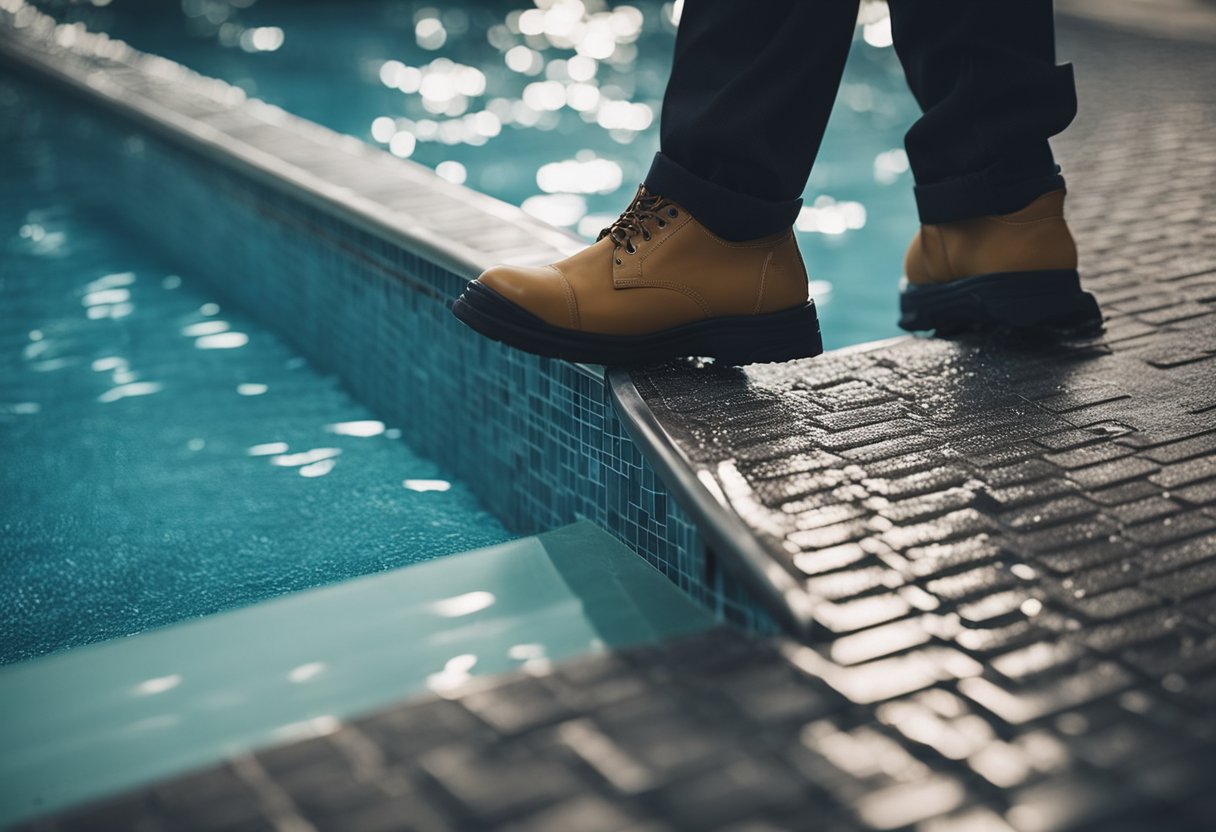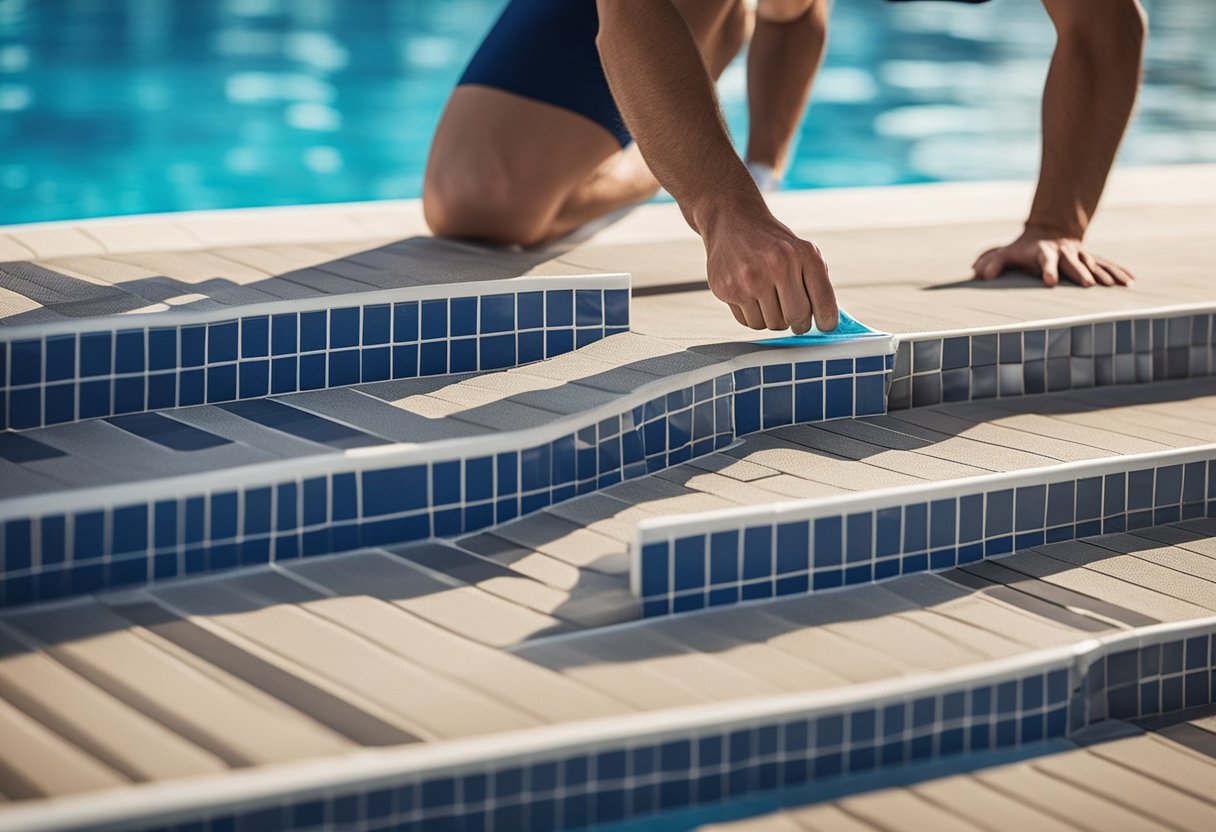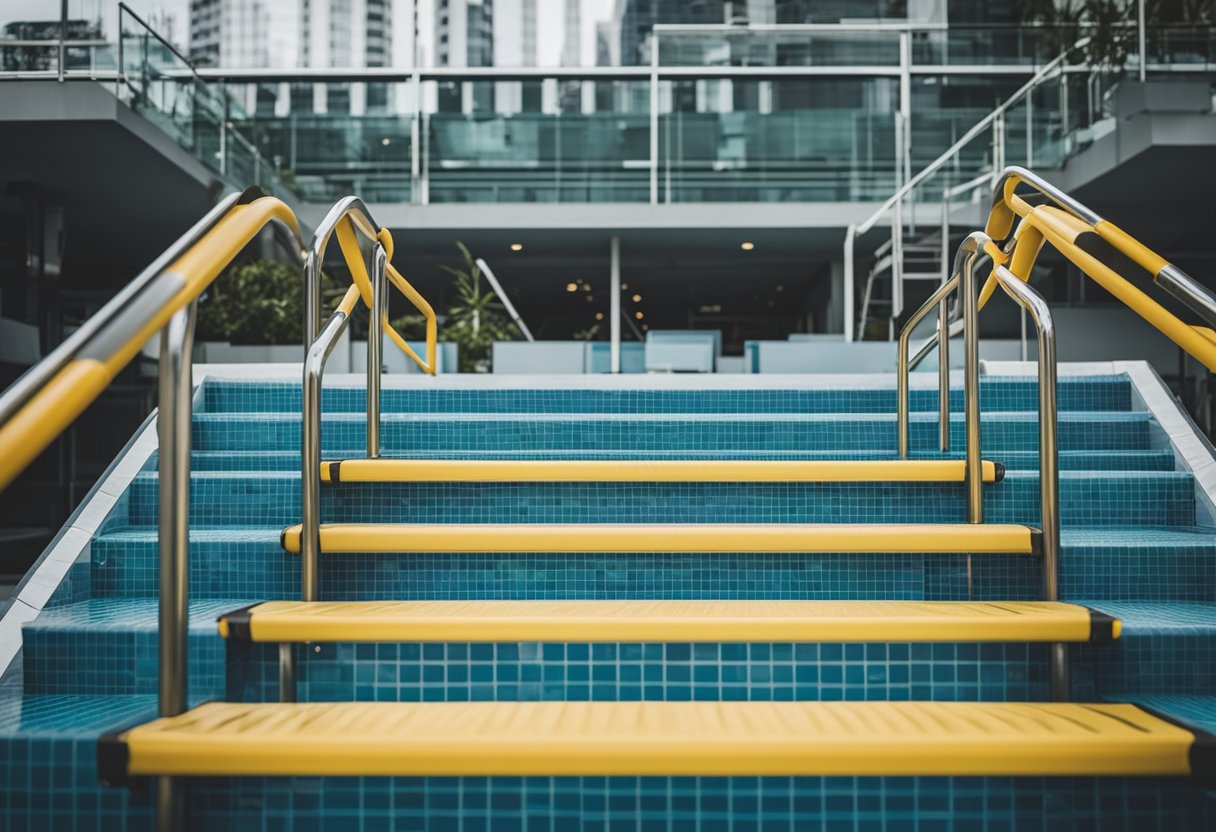As a pool owner, you want to ensure that your pool is a safe and enjoyable place for your family and guests. One common problem that pool owners face is slippery pool steps. Slippery pool steps can be a serious safety hazard, especially for children and the elderly. Fortunately, there are several ways to fix slippery pool steps and make your pool safer and more enjoyable for everyone.
The first step in fixing slippery pool steps is to identify the problem. Slippery pool steps can be caused by a variety of factors, such as algae, mold, or a buildup of dirt and debris. Understanding the cause of the slipperiness can help you choose the right solution for your pool steps. Additionally, it’s important to consider the material of your pool steps, as some materials are more prone to slipperiness than others.
Key Takeaways
- Regular maintenance is key to preventing slippery pool steps.
- Non-slip coatings and mats can be effective solutions for slippery pool steps.
- Professional help may be necessary for severe cases of slippery pool steps.
Identifying the Problem
https://www.youtube.com/watch?v=sITpD7f_Rek&embed=true
As a pool owner, one of the most significant risks that you need to be aware of is the risk of slipping on slippery pool steps. Slippery pool steps can be caused by various factors, including the type of material used to make the steps, algae growth, and other environmental factors.
One of the most common causes of slippery pool steps is the slickness of the fiberglass material. Fiberglass filaments have a high weight-to-surface ratio and have evolved flexibly due to their manufacturing process. This can make the steps extremely slippery, especially when wet.
Another cause of slippery pool steps is the buildup of algae, which can grow on the surface of the steps and make them extremely slippery. Algae thrives in warm and damp environments, making pool steps a perfect breeding ground.
It’s essential to identify the cause of the slippery pool steps to determine the best course of action to fix the problem. This can be done by inspecting the steps and determining the cause of the slipperiness. Once you’ve identified the cause, you can then take the necessary steps to fix the problem.
In the next section, I’ll discuss some of the most effective ways to fix slippery pool steps and reduce the risk of slipping.
Understanding Your Pool Steps Material
https://www.youtube.com/watch?v=zeppM0HX1VE&embed=true
As a pool owner, it’s essential to understand the material of your pool steps to determine the best way to fix slippery steps. Different materials require different techniques. Here are the most common materials used for pool steps:
Vinyl Pool Steps
Vinyl pool steps are made of vinyl liner material. They are flexible and soft to the touch. The steps are usually molded into the pool structure and then covered with a vinyl liner. Vinyl pool steps are not as slippery as other materials, but they can still become slick over time due to algae or other build-ups.
To fix slippery vinyl pool steps, you can use a pool brush to scrub the steps with a cleaning solution. You can also add a non-slip pool mat to the steps to provide additional traction.
Fiberglass Pool Steps
Fiberglass pool steps are made of fiberglass material, which is slick and smooth. The slickness of fiberglass can make the steps very slippery, especially when wet. Fiberglass pool steps are also prone to cracking and fading over time.
To fix slippery fiberglass pool steps, you can add a non-slip coating to the steps. You can also use a pool brush to scrub the steps with a cleaning solution to remove any build-ups that may cause slipperiness.
Concrete Pool Steps
Concrete pool steps are made of concrete material, which is rough and porous. Concrete pool steps can become slippery over time due to algae or other build-ups. They are also prone to cracking and chipping.
To fix slippery concrete pool steps, you can use a pool brush to scrub the steps with a cleaning solution to remove any build-ups. You can also add a non-slip coating to the steps to provide additional traction.
In conclusion, understanding the material of your pool steps is crucial for fixing slippery steps. Whether you have vinyl, fiberglass, or concrete pool steps, there are solutions available to make them less slippery and safer for swimmers.
Regular Maintenance for Pool Steps
https://www.youtube.com/watch?v=kw8oQr2JXdA&embed=true
As a pool owner, I understand the importance of keeping my pool steps clean and free of debris to prevent slips and falls. Regular maintenance is key to ensuring the safety of my family and guests. Here are some tips on how to properly maintain your pool steps:
Brush and Rinse
Using a pool brush or a scrub brush with a pool cleaner, I scrub the surface of the steps to remove any dirt, algae, or other debris. I rinse the steps with clean water afterward to ensure all the debris is removed.
Check pH Levels
It is important to regularly check the pH levels of the pool water to ensure that it is properly balanced. High pH levels can cause build-up on the pool steps, making them slippery and unsafe. I use a pH testing kit to check the levels and adjust them as needed.
Use Chlorine
Chlorine is a great tool for keeping the pool water clean and free of bacteria. I use chlorine tablets or granules to sanitize the water and prevent algae growth on the pool steps.
Bleach Solution
If there is a build-up of algae or other stubborn stains on the pool steps, I use a bleach solution to remove them. I mix one part bleach to four parts water and apply it to the steps with a scrub brush. After letting it sit for a few minutes, I rinse the steps with clean water.
Regular maintenance of pool steps is crucial to ensuring the safety of swimmers. By following these simple steps, I can keep my pool steps clean and slip-free.
Choosing the Right Non-Slip Solutions
https://www.youtube.com/watch?v=lBfeNBxgHfQ&embed=true
Slippery pool steps can be dangerous, but there are many non-slip solutions to choose from. Here are some options to consider:
Traction
Adding traction to your pool steps can be a simple and effective solution. Traction can come in the form of adhesive strips, mats, or treads. These products can be applied directly to the steps, providing a non-slip surface that is easy to install and maintain.
Non-Slip Coating
A non-slip coating is another option to consider. This type of coating is applied to the pool steps and creates a rough texture that provides traction. Non-slip coatings are available in a range of colors and finishes, so you can choose one that complements your pool’s design.
Grit
Grit is another material that can be added to pool steps to create a non-slip surface. Grit is typically mixed into a coating or paint and creates a rough texture that provides traction. Grit is available in different sizes, so you can choose one that provides the level of traction you need.
Non-Slip Mats
Non-slip mats are another option to consider. These mats can be placed directly on top of the pool steps, creating a non-slip surface that is easy to install and remove. Non-slip mats are available in a range of sizes and materials, so you can choose one that meets your needs.
Non-Slip Soles
If you’re looking for a solution that doesn’t involve changing the pool steps themselves, non-slip soles may be the answer. These are special shoes or socks that have a non-slip sole, providing traction when walking on slippery surfaces.
In conclusion, there are many non-slip solutions to choose from when it comes to fixing slippery pool steps. By considering the options above, you can choose the one that is right for you and ensure that your pool is a safe place to enjoy.
Applying Non-Slip Coatings and Mats
https://www.youtube.com/watch?v=yyZbLoini1k&embed=true
When it comes to fixing slippery pool steps, applying non-slip coatings and mats is a popular solution. Non-slip coatings can be applied to the surface of the steps to provide a non-slip surface. These coatings come in various forms such as epoxy coatings, rubberized paints, and slip-resistant sealers. They work by adding texture to the surface of the steps, which increases traction and reduces the risk of slipping.
Before applying the non-slip coating, it’s essential to clean the steps thoroughly. Use a scrub brush with a pool cleaner to scrub the surface of the steps, and rinse them with clean water afterward. If the steps are made of fiberglass, use acetone to clean the surface. Once the steps are clean and dry, apply the non-slip coating according to the manufacturer’s instructions.
Another option is to use non-slip mats on the steps. Non-slip mats are designed to provide a non-slip surface, and they come in various sizes and shapes to fit different step sizes. They work by adding texture to the surface of the steps, which increases traction and reduces the risk of slipping.
When using non-slip mats, it’s essential to ensure that they are properly secured to the steps. Mats that are not secured can slip, creating a tripping hazard. To secure the mats, use double-sided tape or adhesive. Before applying the tape or adhesive, make sure that the surface of the steps is clean and dry.
In addition to non-slip coatings and mats, another option is to add grit to the surface of the steps. Grit can be added to the non-slip coating or applied separately. It works by creating a rough surface, which increases traction and reduces the risk of slipping.
In conclusion, applying non-slip coatings and mats is an effective way to fix slippery pool steps. Non-slip coatings come in various forms and can be applied to the surface of the steps to provide a non-slip surface. Non-slip mats are designed to provide a non-slip surface and come in various sizes and shapes to fit different step sizes. Adding grit to the surface of the steps is another option that can be used to create a rough surface and increase traction.
Safety Measures and Considerations
As a pool owner, ensuring the safety of everyone who uses the pool is of utmost importance. Slippery pool steps can pose a significant risk of slipping and falling, especially for children and the elderly. In this section, I will discuss some safety measures and considerations to keep in mind when fixing slippery pool steps.
Handrails
Having handrails installed on both sides of the pool steps can provide additional support and stability when entering and exiting the pool. Make sure that the handrails are securely attached and can support the weight of a person.
Pool Shoes
Wearing pool shoes with non-slip soles can help prevent slipping on the pool steps. Encourage everyone who uses the pool to wear pool shoes, especially children and the elderly.
Non-Slip Coatings
Applying a non-slip coating specifically designed for pool surfaces can significantly reduce the risk of slipping on the pool steps. Make sure to follow the manufacturer’s instructions when applying the coating.
Regular Maintenance
Regularly cleaning the pool steps can help prevent the buildup of algae and other debris that can make the steps slippery. Use a pool brush or a scrub brush with a pool cleaner to scrub the surface of the steps. Rinse them with clean water afterward.
By following these safety measures and considerations, you can significantly reduce the risk of slipping on the pool steps and ensure the safety of everyone who uses the pool.
Professional Help for Slippery Pool Steps
If you have tried all the DIY methods to fix slippery pool steps, but they are still slippery, it might be time to call in a professional. A professional pool service company has the expertise and tools to fix the problem correctly and safely.
One of the benefits of hiring a professional is that they can assess the condition of your pool steps and determine the best course of action. They can identify any damage, stains, or cracks that may be contributing to the slipperiness and repair them accordingly.
Another advantage of using a professional is that they can help prevent damage to your pool floor and tiles. Some DIY methods may cause damage to the pool surface, which can be costly to repair. A professional can apply non-slip coatings or other products that will not harm the pool surface.
Professional pool service companies use high-quality products and equipment that are not readily available to the public. They also have the experience and training to use these products and equipment safely and effectively. This can give you peace of mind knowing that the job is being done correctly and professionally.
In conclusion, if you have tried all the DIY methods to fix slippery pool steps and they are still slippery, it is time to call in a professional. They have the expertise, tools, and products to fix the problem safely and effectively. Don’t risk damaging your pool surface or tiles by attempting to fix the problem yourself. Hire a professional and enjoy a safe and slip-free swimming experience.
Conclusion
In conclusion, fixing slippery pool steps is an essential safety measure for any pool owner. By taking the necessary steps to address this issue, you can ensure that your pool is safe for everyone to use.
As a customer, it’s essential to choose the right solution that is suitable for your pool and its unique needs. Consider factors such as durability, ease of installation, and cost when selecting a product.
When it comes to fixing slippery pool steps, there are several parameters to consider. The type of pool material, the severity of the slipperiness, and the amount of foot traffic are all critical factors that can impact the effectiveness of your chosen solution.
Overall, by taking the time to research and select the right solution for your pool, you can ensure that your pool steps are safe and slip-free. Remember to always follow the manufacturer’s instructions and take the necessary safety precautions when installing any product.
Frequently Asked Questions
What are some effective solutions for slippery pool steps?
There are several effective solutions for slippery pool steps. One solution is to apply a non-slip coating specifically designed for pool surfaces. Another solution is to install non-slip treads or tape on the steps. Additionally, pool step repair epoxy can be used to fix slippery steps.
Are there any non-slip treads or tape that can be applied underwater?
Yes, there are non-slip treads and tape that can be applied underwater. These products are specifically designed to adhere to wet surfaces and provide traction for swimmers.
How can pool step repair epoxy be used to fix slippery steps?
Pool step repair epoxy can be used to fix slippery steps by filling in any cracks or gaps in the steps and creating a smooth, non-slip surface. The epoxy can be applied with a putty knife and should be allowed to cure for at least 24 hours before the steps are used.
What are some popular options for inground pool steps?
Some popular options for inground pool steps include molded fiberglass steps, vinyl liner steps, and concrete steps. Each type of step has its own advantages and disadvantages, so it is important to choose the option that best fits your needs and budget.
How can pool step markers be used to make steps less slippery?
Pool step markers can be used to make steps less slippery by providing a textured surface that swimmers can grip onto. These markers are easy to install and can be placed on the edges of the steps to provide extra traction.
What are some DIY methods to make pool stairs less slippery?
One DIY method to make pool stairs less slippery is to mix equal parts of water and vinegar in a spray bottle and spray the solution onto the steps. Another method is to sprinkle baking soda onto the steps and scrub them with a pool brush. Additionally, applying a mixture of water and muriatic acid can help remove any algae or other residue that may be causing the steps to be slippery. However, it is important to use caution when working with muriatic acid and to follow all safety precautions.

Hi, I’m Sal Muller of Tooltrip.com. My DIY experience led me to understand essential power tools for home projects. Tooltrip.com guides enthusiasts and professionals in choosing right tools for any job. I provide concise top tool reviews for easier, efficient DIY.

